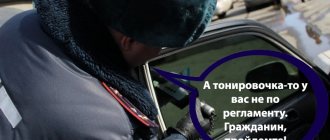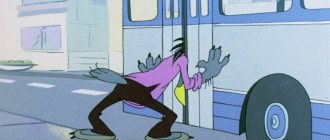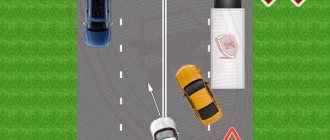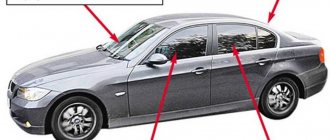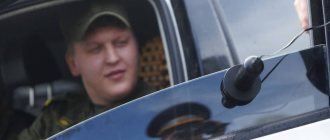Tinting allows you to hide from prying eyes and leave personal belongings and technical devices in the cabin - a radio, video recorder or radar detector. In Russia, tinting of front windows is officially allowed when the light transmittance is at least 70%. Workshops offer a wide range of services and film tinting with much lower throughput. The demand is generated by the fact that it allows the owner to remain incognito. However, there is a penalty for this. What exactly is it and is there a chance to avoid it? Let’s look at it below.
Fine for darkening windows not according to regulations
In 2010, Article 12.5 of the Code of Administrative Offenses was supplemented by Part 3.1, according to which driving a car with windows that do not comply with technical regulations leads to a fine of five hundred rubles (and for repeated violations, the amount does not change). You can pay for it with a 50% discount.
The punishment should not be made more severe at the request of the traffic police, that is, by law you cannot be forced to remove the film on the spot. Although in practice this also happens: the driver signs a resolution, as if agreeing that a violation has taken place, and then the officer demands to “stop illegal actions” (under Article 3 of Federal Law No. 3 “On Police” of 2011) and eliminate the cause violations on site. This is not entirely true, since according to this law the driver only needs to stop operating the vehicle, that is, stop and park, and not remove the film.
Another measure that can be taken against a driver driving a vehicle that is not tinted according to GOST is an inspection of the car and subsequent arrest for 15 days. The basis is disobedience to a police officer under Part 1 of Article 19.3 of the Code of Administrative Offences. However, such a detention or a fine of 500 to 1000 rubles will be illegal, since the requirement to remove the tint is not specified in any law. Consequently, the employee commits arbitrariness under Article 19.1 of the Code of Administrative Offenses and you can write a complaint against him to the traffic police and file an application in court.
In 2021, the State Duma is discussing a bill according to which the punishment for tinting should become more serious. At the same time, this measure will help minimize the situations of lawlessness described above. The fine for the first violation will be one and a half thousand rubles, a second violation will be five thousand rubles, a third will be deprivation of the driver’s license from 2 to 6 months, BUT THIS IS JUST DISCUSSED IN THE STATE DUMA AND HAS NOT COME INTO FORCE!
Punishment system
For tinting that does not meet the conditions of the previously presented standards, the traffic police officer has the right to impose penalties on the car owner, in the form of a protocol indicating Article 12.5 of the Code of Administrative Offenses “Driving a car in the presence of malfunctions or conditions...”.
In particular, clause 3.1 “Use of a vehicle on which there is a colored or transparent film on the windows that does not comply with the requirements of the Technical Regulations” will be applied to the driver.
The penalty for this violation will be 500 rubles.
In addition, the inspector may ask to remove the tinting on the spot or issue an order for tinting, obliging the car owner to eliminate the cause of the malfunction within a certain period of time (set on site, usually 10 days), that is, to remove the film.
Failure to comply with his official requirement, justified by Article 13 of the Law “On the Police” entails the driver’s responsibility as provided for in Article 19.3 of the Code of Administrative Offenses, Part 1 “Disobedience to the legal requirement of a police officer.”
The article will tell you how to remove tinting from glass yourself: How to remove tinting from glass yourself. Liquid tinting for windows, read about it here.
Thus, if within the specified time the car owner does not eliminate the cause of the violation, another administrative case will be initiated against him, which may end, at best, with a fine in the amount of 500 to 1,000 rubles. , and in the worst case - arrest for up to 15 days.
It should be emphasized that today the inspector does not have the authority to influence the driver differently. Deprivation of rights, removal of license plates or seizure of a vehicle is unlawful. A similar situation applies to cases when a police officer tries to remove the film on his own; he does not have the right to do so.
Which option is acceptable?
What car windows should be like is regulated by the following documents:
- GOST No. 32565 “Safety glass for land vehicles”.
- Adj. 8 clause 4 of the technical regulations of the customs union “On the safety of wheeled vehicles”.
- Clause 7.3 Traffic Regulations of the Russian Federation.
These standards impose a number of requirements on car windows:
- Tinting is permitted if the light transmittance of the windshield and side windows of the front row is 70% or more;
- rear windows can be darkened as desired if rear-view mirrors are present;
- the thickness of the dark strip on top of the windshield is up to 140 mm;
- The use of mirror film for all glass without exception is prohibited.
Regulations
Before you figure out what the fine for tinting front windows is in 2021, it’s worth understanding what the penalties are based on. There are only three documents regulating the light transmission of car windows.
- GOST 33997-2016. This document regulates the main points for admitting vehicles to operation. It is this document that the SDA is based on, that is, all technical characteristics mentioned in the “rules” must be checked against this GOST.
- Technical Regulations of the Customs Union “On the safety of wheeled vehicles”. This is an expanded document that is valid not only in Russia. Among other things, there are also instructions on what tinting is allowed and other important nuances.
- Order of the Ministry of Internal Affairs No. 664. Announced in December 2021, it describes the capabilities of traffic police officers to check the tinting of car windows.
- Code of Administrative Offenses of the Russian Federation Article 12.5 clause 3.1. The amount of fines and other sanctions related to the degree of tinting of the car is indicated here.
- GOST 27902-88. Regulates the rules for measuring the transparency of automobile glass. We’ll tell you later how it’s used and how it can help a car enthusiast. Now it is enough to understand that this document is valid and can influence the preparation of the protocol.
Based on all the documents described, the inspector will issue you a fine or release you.
Who takes measurements and issues fines?
To record a violation under Part 3.1 of Art. 12.5 of the Code of Administrative Offenses, the luminous transmittance of automobile glass must first be measured. This action can be carried out by:
- traffic police technical supervision is a body that checks whether a car meets technical requirements;
- An employee of the State Traffic Inspectorate (the check is carried out on the basis of Articles 23.3, 26.8, 28.3 of the Administrative Code).
Metering Tools
The luminous transmittance of glass is measured using a taumeter. The most popular companies in the Russian Federation are “Svet”, “Raster”, “Blik+”, “Blik-N” and “Tonic”.
The toilet meter operates from the car cigarette lighter. The meter voltage is usually 12 V with a deviation of no more than 0.6 V (2%).
The device must be sealed and have a tag with the time the serviceability was checked (no later than 1 year ago, at the moment).
Measuring rules
The driver has the right to demand from the inspector a document showing that he can carry out measurements properly, and a certificate of the meter confirming the device’s compliance with GOST.
The traffic police officer is required to record the data obtained during measurements.
Direct measurements are taken on washed and dried glass, at three points. Temperature, pressure and humidity indicators are preliminarily measured, which is due to the characteristics of the toilet meter in various weather conditions.
Average values for measurement:
- temperature from -10 to +40 degrees;
- humidity no more than 60%;
- pressure 86-106 kPa.
Thus, in rain, fog or frost, the measurements obtained may not correspond to reality. Although these indicators vary quite widely among different toilet meters. Thus, “Svet” operates in the range from -40 to +40 degrees, and “Blik-N” is capable of correctly measuring light transmittance even at 95% humidity.
Note that illumination does not affect the operation of the devices in any way, that is, the indicators will not differ in the light and dark hours of the day.
What tinting is allowed according to GOST?
“Habit is second nature,” says popular wisdom, and in the case of tinting this is further confirmed. It is out of habit that the word “GOST” is often used colloquially when speaking about a document regulating these standards. However, for several years now, the rules in this area have been established by a different type of regulation.
At the moment, the document that determines the possibility of tinting car windows is the Technical Regulations of the Customs Union “On the Safety of Wheeled Vehicles”, and more precisely – Appendix No. 8 to it, called “Requirements for vehicles in operation”, section 4 which is called “Visibility Requirement” (hereinafter, Requirements), and contains the parameters we need.
At the same time, there is also a current GOST 32565-2013, confirming the same standards, but only within the framework of front-view glass (70%, regardless of the type of glass - tempered or multi-layer). Moreover, this document establishes standards for conducting inspections, so we will return to it later.
What kind of tint do the Requirements allow? Let's look at the categories selected above:
| Glazing category | Tinting standards |
| Rear window | If there are side mirrors - no restrictions (with the exception of mirror tinting - it is prohibited). |
| Side rear windows | |
| Side front | Light transmittance is at least 70%, and in the case of using vehicle reservations - at least 60%. |
| Windshield (windshield), excluding the part indicated below | |
| Top stripe on the windshield (dark, colored, athermal, etc.) | For passenger vehicles - no more than 14 cm (140 mm); for some types of large-capacity vehicles, the width of the strip is allowed to the upper edge of the working area of the windshield wipers. |
8(800)350-23-68
Dmitry Konstantinovich
Expert of the site "Legal Consultant"
Ask a Question
In simple words, car service centers often give the following advice: tint the rear windows as you wish, and on the front windows use a film with a light transmittance of at least 70%. If you follow these tips in practice, you can end up in an unpleasant situation. Everything is correct with the rear ones - it doesn’t matter what they look like, even if they’re completely black. But there is a nuance with the front ones. The fact is that the indicated 70% is the total transmission capacity of the finished window, and the glass initially does not transmit 100% of the light, and over time this figure does not change for the better. If, for example, the glass itself does not transmit at least 1%, then when added to a 70% film, the light transmittance will be 69%, which may be considered a violation and a fine imposed.
How to avoid fines
Even if the vehicle tinting does not comply with the established regulations, there are several loopholes that make it possible to evade payment. Let's consider several ways.
If measurements are not taken
It may turn out that the State Traffic Inspectorate inspector does not have a toilet meter. He will not be able to take measurements and will be forced to impose a fine of 500 rubles under another article of the Administrative Code - 12.5 part 1. However, if the motorist recorded the process of communication with the inspector on a video recorder, when appealing the fine it will be easy to prove that the employee can assess the light transmittance of the film “by eye” could not. Therefore, it is not a fact that it impeded the driver’s visibility and created a threat to the safety of the vehicle.
Article 12.5 shall apply to removable tinting that is considered a visibility-impairing condition.
If the measurement was taken in bad weather
The protocol specifies the name of the toilet meter used for measurement. Currently, no GOSTs have been developed that would regulate the weather conditions acceptable for measurements. Therefore, the instructions for the device are the only document on the basis of which you can try to appeal the fine.
It will be more difficult to avoid receiving a fine at the time a violation is recorded, since the inspector is not required to carry the instructions with him. You can find it on the Internet and challenge the punishment if the weather conditions do not meet the stated requirements.
If there are errors in the protocol or resolution
The likelihood of appealing a fine based on errors in procedural documents is quite low. Especially if the errors do not change the essence of the matter - for example, the name of the offender or address is incorrectly indicated.
The chances are slightly higher when the inspector incorrectly records the light transmittance of the glass or vehicle data. In this case, the court or the traffic police may side with the driver and cancel the decision.
If you don't roll up the windows
The driver may refuse to raise the front windows when detained by traffic police officers in order to hide the fact of tinting. Of course, this is only relevant if the windshield is not tinted. It is worth understanding that if you refuse to comply with a legal requirement, the inspector has the right to attract the motorist under Art. 19.3 of the Administrative Code and impose a penalty in the form of a fine of 500 rubles or arrest for up to 15 days.
There is no point in referring to broken window regulators, because according to the law, the inspector can independently check whether the mechanism is broken.
Another “life hack” is to install a special button that blocks the lifting mechanism. But the effectiveness of this step will depend on how principled and interested the traffic police officer is. Nothing prevents him from inspecting the entire car and finding the button.
Bad way to avoid a fine
This is a rather promising option, but not recommended - because instead of a minor fine, there is a risk of getting into a lot of trouble. The method is to not stop at the request of employees and try to hide. With a high degree of probability, inspectors will not pursue and the offender will get away with it. But if this does happen and the motorist is caught, he will be fined under Part 2 of Art. 12.25 of the Code of Administrative Offences, and can also conduct a vehicle search and a medical examination for alcohol or drug intoxication.
Fines for incorrect tinting
In Russia they like to fine people for installing the wrong type of tint. In certain years, dark tint film was included in the TOP 10 fines on Russian roads. Now the situation is simpler; drivers have already learned to circumvent this charge in different ways. However, there is a fine, and to this day it is often issued at traffic police posts. True, people have stopped stopping people directly for incorrect tinting much less frequently.
The specifics of the penalties are as follows:
· this monetary penalty is regulated by part 3 of Article 12.5 of the Code of Administrative Offenses, a fine is set in the amount of 500 rubles, no deprivation or arrest can be made;
· the fine can also be supplemented by an order from the inspector to remove the tint, in which case the film must be dismantled directly at the stop site without delay;
· license plates are not removed from the car, this vandal method of punishment remained back in 2014, when the rampant police presence on Russian roads was too unpleasant for drivers;
· also, the size of the fine does not depend on how many glasses are tinted; the amount of the penalty will always be standard - 500 rubles;
· a repeated fine can be imposed at least at the next checkpoint; during the day of the trip, you can collect as many such fines as 500 rubles each.
Legislation is evolving and takes into account all the possible tricks that car owners come up with. But motorists in our country are not the stupidest; they are actively looking for an opportunity to circumvent the law. However, as far as tinting is concerned, there is nothing to avoid. If measurements show that the permissible darkening standard is exceeded, you will have to pay. Here, not a single court will cancel the fine if all the documents are drawn up correctly. And the amount of the penalty is not so large, so almost no one goes to court to have the punishment annulled. Moreover, you can pay the fine with a 50% discount if you do it quickly.
Instructions: how to avoid a fine for tinting
If the windows in a vehicle are not tinted according to GOST, the driver still has a chance to avoid punishment. Usually the film is glued to the inside of the glass. This circumstance gives the car owner the right to treat the procedure for measuring the light transmittance of glass as an inspection of the car, and not an inspection, since the inspector will need to get inside the car. An inspection requires compelling reasons and the involvement of two witnesses and, in general, is a rather lengthy procedure. If the inspector refuses to conduct an inspection, his actions can be appealed, based on the fact that the requirements of the current legislation were not met.
To avoid paying a fine when stopped by inspectors, it is recommended to proceed as follows:
- Turn on the voice recorder or video recorder filming in the cabin.
- Ask to indicate the reason for the stop and show your ID and badge, read the information out loud.
- To measure the light transmittance of glass, ask to draw up an inspection protocol and involve witnesses. If the inspector demands to open the car door and claims that you are breaking the law by refusing to comply with his demands, answer that this is an abuse of power on his part and you will be forced to contact the prosecutor's office.
- Remind the employee that long-term detention without a protocol is impossible under Art. 28.5 Code of Administrative Offences. Either it must be drawn up, or you must be released.
- If nothing happens, dial the traffic police helpline and report the unlawful actions of their employee. Indicate its data recorded on video or voice recorder. After this, the inspector should definitely let you go.
How to avoid a fine for tinting if no measurements were taken?
The main evidence of violation of glass light transmission requirements is the measurement result. The resulting coefficient serves as the basis for drawing up a protocol. When a decision on administrative liability is made without taking measurements, the actions of a traffic police officer are considered illegal. It is recommended to make a video recording and present it to the court to argue your position. Such a decision by a judge or higher authority is canceled.
How and where to challenge the inspector’s decision
In order to appeal a decision drawn up by an inspector, you need to file a complaint addressed to the head of the traffic police department, whose officer issued the fine. 10 calendar days are given for this (according to Part 1 of Article 30.3 of the Administrative Code). The driver must attach to the complaint any evidence indicating the absence of guilt or a violation on the part of the inspector, a resolution and a protocol of refusal to pay a fine. The inspection has 10 days to review and respond.
If a refusal is received, then, according to Article 30.1 of the Code of Administrative Offenses, the motorist has the right to go to court - file a complaint by registered mail or through the office. The court can consider the case for up to 60 days. If the answer is negative, you can appeal the decision to a higher judicial authority. Payment of the fine will be deferred during the trial.
Let's sum it up
Despite the objective advantages of using tint film, you should carefully consider the requirements of the laws in Russia. Unfortunately, numerous “life hacks” from Youtube bloggers do not work in practice; you may be fined for tinting at the next traffic police post. And the inspector has an undeniable reason to stop the car.
Many car owners use tint film, which is acceptable in terms of light transmission. But here another problem arises: legal requirements do not always work in practice. Very often, devices show slightly different information when tested, and this becomes the cause of real problems. If you are sure that the tint is correct, but you still receive a fine, you can go to court. But keep in mind that if you lose, you will have to pay not only a fine, but also legal costs. So such actions will not always be justified. It is better to take a small gap for possible errors in the operation of the devices.
Inspector Tricks
While drivers are coming up with new methods to circumvent penalties for tinting, inspectors are also using tricks that allow them to fine or even detain violators.
In parallel with the fine, a warning is issued, which obliges the car owner to correct the problem - remove the film. A repeated stop results in a fine of 1,000 rubles or arrest for up to 15 days. Read more about “What is the fine for re-tinting windows?” you will learn from this article.
